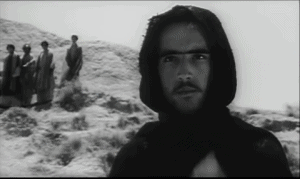In the Spiritual Exercises, St. Ignatius invites us to imagine scenes from the gospel in our prayer. In this “composition of place,” we try to see the furnishings in a room, inhale the smells wafting in a market, hear the sound of the waves crashing on the sea of Galilee and chew the doughy bread at the last supper. Being situated in 2020, we have the ability to use the cinematic masterpieces of brilliant filmmakers to aid our contemplations. Knowing that many use the time of Holy Week to reflect on Jesus’ life, death, and resurrection through film, we wanted to share some movies that have aided our own prayerful reflections on the gospel. Please share your thoughts and favorite films below.
Jason McCreery – Jesus Christ Superstar (1973)

The film adaptation of the musical by Andrew Lloyd Webber and Tim Rice, the 1973 Jesus Christ Superstar is a bit of a strange movie. The rock opera is set ostensibly in first century Palestine, but includes ‘70s-inspired costumes and military planes flying overhead. As a kid I remember some of the songs playing through my head during the reading of the Passion during Holy Week. But what keeps me coming back to the music is not (just) that it’s catchy; it is far and away my favorite interpretation of Judas Iscariot.
Judas, when read in the gospel stories, can come across as a moustache-twirling villain. He resents Jesus’s ministry – the writer of John goes out of his way to note that Judas stole money from their common purse. However, this story presents a sympathetic Judas. In the opening song, “Heaven on their Minds,” he pleads,
“I’ve been your right hand man all along / You have set them all on fire / They think they’ve found the new Messiah / And they’ll hurt you when they find they’re wrong”
We are given a very human explanation for his betrayal: Judas is scared that his friend is getting swept away by ideology. He is unable to see Jesus as anything more than the carpenter from Nazareth he had grown to admire. Judas is afraid, but only because he doesn’t want to lose someone he loves. How many times have I missed others’ goodness, because I grasped onto who they used to be?
Jesus Christ Superstar is available for rental or purchase on Amazon Prime, iTunes, and Google Play.
Ryan Birjoo – Pasolini’s The Gospel According to St. Matthew (1964)

True to its name, this film directed by Pier Paolo Pasolini recounts the events of Matthew almost word for word. Pasolini’s masterpiece displays creativity through raw acting (most of the actors were rural villagers with little professional training), the eclectic soundtrack (featuring everything from Bach concertos to the African American gospel song “Sometimes I feel like a motherless child”), and the harsh but stunning vistas of the rugged southern Italian countryside.
But, I am most drawn to Pasolini’s work because of the dynamism and authenticity of Jesus. Coming from an atheistic vantage point, Pasolini’s fascination with Christ is especially curious. His Jesus is one who is entirely centered on the urgent preaching of the reign of God with an unnerving conviction. Pasolini shows the radicality and forcefulness of the beatitudes with a sequence of close-up shots in which Jesus almost shouts them over swirling wind. Jesus, operating from this paradigm, is not afraid to confront unjust authorities and earns the ire of many. His tenderness is undoubtedly reserved for the poor, sick, and downtrodden with whom he shares gazes of empathy and healing caresses.
Pasolini’s faithful rendering shows us that Jesus of Nazareth was controversial. He attracted, repelled, and intrigued. Who was this man that plucked the strings of the human heart, yielding dueling notes of admiration and violence? Pasolini’s Jesus most clearly identifies himself with those who lack. We are reminded of our own neediness in front of this question. Jesus, then and now, does not easily fit into our categories. How does Jesus surprise you today? Can you bring this sensation to prayer?
Pasolini’s The Gospel According to Saint Matthew is available for free on YouTube.
Shane Liesegang – Martin Scorcese’s The Last Temptation of Christ (1988)

The Last Temptation of Christ has a bit of a bad reputation in some circles, because of the very human side of Jesus that it’s willing to portray. Leaving aside that he and all the apostles are portrayed as white men with New York accents, it feels like a grounded, realistic portrayal of how the earthly ministry may have gone and the psychological reality of being divine and being human. When he’s about to preach for the first time, he ponders, “What if I say the wrong thing? What if I say the right thing?” It’s easy to tell which terrifies him more.
The movie is structured around temptations that actually appear in the Gospels, but takes an imaginative turn in the final sequence, the titular Last Temptation, where Jesus is presented with the prospect of living a totally normal life, of not being the Messiah. It includes family, work, joy, and sorrow. If we forget that it is explicitly a temptation sent from the devil, the more sensual aspects would be offensive, but if we’re willing to go with it, we see Jesus at his most human. To deny that humanity is one of the earliest (and most persistent) heresies, but to truly embrace it is the challenge of our faith. If Christ was fully human, then he felt the same desires and, yes, temptations as all of us. That includes not wanting to die. Last Temptation invites us to enter into that state of mind and dwell in it, bringing an even greater meaning to the sacrifice we know must come at the end.
The Last Temptation of Christ is available on Amazon Prime, and the novel on which it is based is also well worth your time.
Ian Peoples – Mel Gibson’s The Passion of the Christ (2004)

Few movies have stirred up controversy like Mel Gibson’s The Passion of the Christ. Some have labeled it sadistic, while others question whether the film encourages antisemitic sentiments. These controversies are serious and worth discussion, but I want to share my personal experience of the movie.
I remember seeing the film when it first came to theaters in 2004. My friend’s Baptist Church was taking a group to watch it on a school day. For some reason, my Mom let me skip out early from class to attend the film with the group. The graphic nature of Jesus’s crucifixion hit all of us hard. Everyone was silent—a somber silence— as we left the theater and got back in the church van to return home.
What was it about the film that silenced us?
The Third Week of the Spiritual Exercises of St. Ignatius helps provide an answer. In the Third Week, we are called to witness the Passion and death of Christ. During my 30 day retreat in novitiate, there was a prayer period during the Third Week in which I helped take Christ’s body off the cross. I felt the weight of his death. Dead weight. It was crushing. “You died. You died,” I kept repeating in prayer. Jesus’s death became real. I experienced it.
I think that experience was also what silenced us in that van all those years ago.
The Passion of the Christ is bloody; it is meant to depict the awful death that Christ experienced. We often want to turn our heads from such violence, in films and in real life. But walking with Christ through his Passion also gives us the strength to accompany others in their own suffering. In another prayer during that 30 day retreat, Jesus told me he was still being crucified today: in the abused, the abandoned, the elderly, people on the streets, the forgotten people of the world. From the cross, he called me to be attentive to them.
And death is not the only experience of Jesus on display in the film. It also portrays Jesus’s love for his mother, for his friends. It shows the fear he experienced in the Agony of the Garden. But ultimately, it shows the triumph of the Resurrection.
Even if you don’t watch the film, I encourage you to pray through the Passion narrative. Jesus died a violent death. We need to witness that so we can celebrate even more in Christ’s Resurrection. Then we can echo Paul’s words, “Where, O death, is your victory? Where, O death, is your sting?” 1
The Passion of the Christ is available on Youtube.
- 1 Corinthians 15:55 ↩


